- "Ora vuoi sentire un po' dell'Amleto?"
- "Oh, conosco l'Amleto. E ciò che lui dice con ironia, io lo dico con piena convinzione. "L'uomo! Che capolavoro è l'uomo! Nobile d'intelletto, dotato di una illimitata varietà di talenti, esatto nella sua forma e in tutti i suoi atti. Compiuta ammirevole creazione, pari a un dio nella mente e nelle azioni a un angelo... ""
- "Ma tu sai che la tua specie non è così."
- "Io credo però che lo diventeremo un giorno, Q. È questo che ti preoccupa, vero?"
- - Q e Jean-Luc Picard (TNG: "Il ritorno di Q")
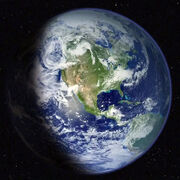
Terra – Il pianeta natale degli umani
La storia dell'umanità è la storia della razza umana del pianeta Terra. La storia terrestre viene studiata da umani e non umani. Chi studia la storia viene definito come "storico". Un famoso storico, John Gill, insegnò storia nel XXIII secolo parlando delle cause e le motivazioni delle vicende storiche, piuttosto che elencare date ed eventi. (TOS: "Gli schemi della forza")
Origini[]
Un antico umanoide
Secondo Q, approssimativamente 3,5 miliardi di anni fa, "dando o prendendo un eone o due", un gruppo di aminoacidi si combinò formando le prime proteine, nella regione della Terra oggi identificata come Francia. Questa prima vita sul pianeta sviluppò, tra l'altro, la specie umana. (TNG: "Ieri, oggi, domani")
Venne dimostrato nel 2369 che molti umanoidi della Via Lattea erano discendenti da una singola razza umanoide, che inseminò i mondi con diverse sequenze del DNA. (TNG: "Il segreto della vita")
Approssimativamente 290 milioni di anni fa, la razza semi-acquatica degli Eryops viveva sulla Terra. Gli Eryops erano probabilmente l'ultimo anello di collegamento che portò alla separazione in dinosauri e mammiferi. La linea dei mammiferi portò agli umani. (VOY: "L'origine della specie")
Dai circa 200.000 ai 28.000 anni fa, due specie di umani coesistevano sul pianeta, gli umani moderni ed i Neanderthal. Tuttavia i Neanderthal si estinsero. (ENT: "Caro dottore")
Storia antica[]
![]() Translation in progress - Traduzione in corso
Translation in progress - Traduzione in corso
La civilizzazione Greca avvenne approssimativamente nel 2700 a.C. Gran parte della cultura e filosofia terrestre proveniva dai Greci. Per il capitano James T. Kirk del XXIII secolo, la civilizzazione Greca veniva vista come l'inizio dell' "Età dell'oro". (TOS: "Dominati da Apollo")
Un'altra antica civiltà, gli Egiziani, costruirono enormi piramidi tra le loro opere importanti. La Grande Piramide di Giza era la più grande delle piramidi costruite in Egitto e completata nel 2600 a.C.. La costruzione della piramide venne osservata da alcuni crononauti provenienti dal 2769. (ENT: "Guerra temporale")
Alcune battaglie avvenute nelle antiche epoche dell'umanità vennero ricordate durante il XXIV secolo. Una di queste battaglie fu combattuta da un piccolo gruppo di Spartani guidati dal re Leonida, che difese un passo di montagna contro il vasto esercito Persiano nella Battaglia delle Termopili durante il 480 a.C.. Gli Spartani combatterono un' "eroica lotta" (secondo Julian Bashir), fino a quando non vennero spazzati via. (DS9: "Quel che si lascia")
Un carro Romano
L'impero Romano – acquistò importanza durante il primo secolo a.C., durando fino al XV secolo – era la prima potenza umana ad essere diventata molto influente. L'imperatore Romano Cesare Augusto (63 a.C. – 14 d.C.) era visto da molti, tra cui Khan, come colui che fece grandi cose per l'Impero durante il suo regno. (TOS: "Spazio profondo") L'Impero Romano veniva visto da Jean-Luc Picard come la civiltà che iniziò a decadere nel V secolo quando i Visigoti attaccarono la capitale Roma durante il regno dell'Imperatore Honorious. (TNG: "L'attacco dei Borg")
Successivamente una popolare religione cominciò a diffondersi nell'Impero, il Cristianesimo, con una filosofia base, che Spock riassunse in "amore e fratellanza totali". Il Cristianesimo si diffuse durante il I secolo dagli insegnamenti di Gesù Cristo, considerato come il figlio di Dio. (TOS: "Nell'arena con i gladiatori")
Storia pre-curvatura[]
Un membro della Specie 8472 parlò degli umani nel 2375. Disse "A prima sembrano primitivi. Impurità genetiche, niente telepatia, violenti. Ma allo stesso tempo hanno espresso in diversi modi i loro ideali: letteratura, arte, musica." (VOY: "La teoria di Shaw") Sfortunatamente, la storia umana prima della scoperta della velocità di curvatura, in molti modi, non e stata definita dalla letteratura, l'arte, e la musica, ma da conflitti militari, piaghe e da barbarie.
Un cavaliere giostra su un cavallo
The trend begins with a series of related military campaigns – fought for causes both religious and political – that took place during the 11th century through the 13th century. These were known as the Crusades. These wars gave Human history "character" according to Q. (DS9: "Q-Less")
Half of Europe was killed by the bubonic plague circa 1334. Flint saw it that summer from Constantinople: "... It marched through the streets, the sewers. It left the city by ox cart, by sea, to kill half of Europe. The rats, rustling and squealing in the night as they, too, died." (TOS: "Requiem for Methuselah")
Beginning in 1478, the Spanish Inquisition was founded in Spain to suppress heresies against the Christian religion. The Inquisition was regarded by Humans as a particularly brutal institution into at least the 24th century, and was regarded by Q as another historical event that provided character to Humanity and kept it from being boring. (Star Trek IV: Rotta verso la Terra; DS9: "Q-Less")
By 1485, Earth had recovered from plague and war to achieve a technological level equivalent to a "B" rating on the Industrial Scale used by 23rd century Starfleet. (TOS: "Spock's Brain")
Another inquisition in the name of Christianity took place during the 17th century. The scientist Galileo Galilei publicly supported the idea that the Earth was not the center of the universe. He was tried and convicted of heresy in 1633 by an inquisition as a result, and many of his books were burned. (DS9: "In the Hands of the Prophets")
The 17th century also saw the start of many uprisings and revolutions against oppressive governments and empires. The Pueblo Revolt in 1680 was one. As described by Deanna Troi and Anthwara in 2370:
- Troi: "[S]everal Indian tribes rose up against their Spanish overlords and drove them out of what is now called New Mexico."
- Anthwara: "Ten years later, the Spanish returned to reconquer the area. They were ... brutal ... I would use the word savage. They killed our people by the hundreds ... maimed thousands more."
According to Anthwara, one of the Spaniards was an ancestor of Picard's named Javier Maribona-Picard. (TNG: "Journey's End")
George Washington
Another took place in the late 18th century, when George Washington helped win a war for his colonies' independence from Great Britain. This was generally known as the American Revolution and resulted in the establishment of the United States of America. In 2366 some, such as Beverly Crusher, considered Washington a military general; others, such as Kyril Finn, considered him a terrorist. (TNG: "The High Ground")
Commerce arose in the United States following the revolution, and throughout the 18th century and 19th century, ocean-going "Yankee Traders" sailed the oceans in search of mercantile opportunity. (TNG: "The Last Outpost")
In 1794, army general Napoléon Bonaparte rose to power, installing himself as absolute ruler of France in 1799, declared himself Emperor of France, and subsequently dominated Europe. The British Royal Navy, led by Admiral Horatio Nelson, defeated the combined French and Spanish fleet at the Battle of Trafalgar in October 1805. Napoleon was ultimately defeated at Waterloo in 1815 due to the combined efforts of the British General Wellington, and the Prussian General Blucher. (TNG: "Hide and Q", "The Best of Both Worlds"; VOY: "The Thaw")
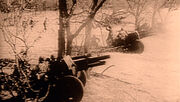
The destructive mechanization of World War I
Human civilization experienced major wars that involved nearly every continent on Earth during the 20th and 21st centuries. The first two such wars – the first and second World Wars – saw six million and eleven million Humans die, respectively, from the effects of despotism alone. The third resulted in 37 million such deaths, and a total of 600 million Human deaths. (TOS: "Bread and Circuses"; Star Trek: Primo contatto; VOY: "In the Flesh")
Adolf Hitler marches with Nazi flag
The Second World War was a conflict, in part, between the forces of fascism – epitomized by Germany's Adolf Hitler and his Nazi political party – and those who opposed such a form of government. (TOS: "The City on the Edge of Forever") Initially assuming an official position of neutrality, the United States fully entered the conflict after a Japanese attack at Pearl Harbor. (TNG: "The Enemy") Hitler and his allies were defeated, but left controversy in their wake. In the 23rd century, some, such as Spock, saw the Nazis as sadistic; some, such as Kirk saw them as "brutal, perverted" and that they "had to be destroyed at a terrible cost". Still others, such as John Gill, saw them governing over the "most efficient state... Earth ever knew", and believed that some of the Nazi approaches could prove beneficial to a society. Spock agreed with Gill, at least as to efficiency: "That tiny country – beaten, bankrupt, defeated, rose in a few years to stand only one step away from global domination." (TOS: "Patterns of Force"; VOY: "The Killing Game", "The Killing Game, Part II"; ENT: "Storm Front", "Storm Front, Part II")
Multiple brush wars occurred on the Asian continent involving two great powers. (TOS: "A Private Little War")
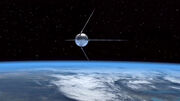
Sputnik I in orbit of Earth in 1957
The 20th century also saw the rise of nuclear weaponry and the beginnings of space exploration. 1968, the year in which a malfunctioning orbital nuclear weapon nearly detonated, was viewed by 23rd century Humans as one of the most critical years on record. Then-current Earth crises "would fill a tape bank", according to Spock. Assassinations, government coups, wars in Asia, the Communist/Capitalist conflicts, and orbiting hydrogen bombs were among the greatest problems facing Humanity at that time. (TOS: "Assignment: Earth", "A Private Little War", "The Omega Glory") Despite this, Humanity first landed two men on Earth's moon and returned them safely to Earth the following year. (VOY: "One Small Step", "Threshold"; ENT: "Carbon Creek")
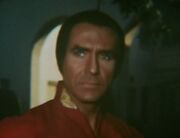
Khan Noonien Singh
The 20th century also saw the start of genetic modifications to the Human genome and the creation of Humans (popularly known as Augments) made stronger, faster, and smarter by the hand of scientists. In 1993, a group of Augments seized power simultaneously in over forty nations and sparked the Eugenics Wars. The wars were particularly devastating, and during them civilization was on the verge of collapse in some parts of the world. (TOS: "Space Seed"; Star Trek II: L'ira di Khan) The terrible experiences that Humanity had with genetic manipulation resulted in long lasting prohibitions against intentional "improvement" of the Human genome well into the 24th century. (DS9: "Doctor Bashir, I Presume")
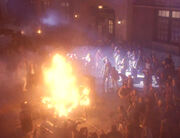
La rivolta di Bell a San Francisco (2024)
The United States suffered economic setbacks in the early 2000s. They were addressed circa 2020 by establishing Sanctuary Districts in major US cities. These walled districts were originally created to help America's massive homeless and jobless population. Instead, the districts became little more than prisons for the destitute and the mentally ill. In September of 2024, mounting tensions in the Sanctuary Districts culminated in the Bell Riots. Political fallout from the riots resulted in the abolition of the districts and the United States finally began to face the serious social problems it had struggled with for over a century. (DS9: "Past Tense, Part I", "Past Tense, Part II")
During the early 2000s, the international scene was deteriorating as well. The United Nations had been reorganized as the New United Nations. (TNG: "Encounter at Farpoint") A number of nations joined together in a union known as the Eastern Coalition. Hostilities between the Eastern Coalition and forces including the United States broke out in 2026 as World War III. The conflict soon escalated into full-blown nuclear holocaust, engulfing much of the globe and again nearly returning Human civilization to a dark age. 600 million people died across the planet as a result. The subsequent collapse of the global economy, political systems, and the drastic environmental effects of the war devastated those nations which had escaped direct nuclear attack. (Star Trek: Primo contatto; VOY: "In the Flesh"; ENT: "In A Mirror Darkly" production art)
With most of the major governments collapsed, law and order soon degraded into a "guilty-until-proven-innocent", lawyer-free show trial system which lasted until 2079 in some parts of the world. (Star Trek: Primo contatto; TNG: "Encounter at Farpoint", "All Good Things...")
The period from the 19th to the late 21st centuries also saw dramatic environmental degredation due to human activities. Humans were responsible for the extinction of many species, including the Draco lizard, White rhinoceros, the Buffalo, and the Humpback Whale (the latter would eventually prove to be sentient and would be brought back from extinction by James Kirk). Human industrial activities also resulted in massive air pollution and degredation of Earth's ozone layer. The nuclear wars led to several "nuclear winters", as well as radiation poisoning of both humans and animals.
The Ares IV command module in orbit over Mars
Around this same time Humanity was still making efforts to explore space. After advances in sub-light propulsion rendered sleeper ships a thing of the past around 2018, manned and unmanned exploration of space further advanced. Colonel Shaun Geoffrey Christopher led the first successful mission to Saturn. (TOS: "Space Seed", "Tomorrow is Yesterday") In 2032, a successful manned mission to Mars, Ares IV, took place in the midst of world war. Although the command module was lost in a graviton ellipse, this mission was considered by some as a precursor for Humankind's further exploration of space. (VOY: "One Small Step") And in 2037, the Charybdis was launched by the United States in a third attempt to take Humans beyond the Sol system. Unknown at the time, that ship was swept off course by an unknown alien force and finally reached the Theta 116 system. (TNG: "The Royale")
Primo contatto[]
Dr. Zefram Cochrane
After the last global conflict, Dr. Zefram Cochrane made mankind's first faster-than-light spaceflight in 2063. This resulted in the first formal post-warp contact by an interstellar race: the Vulcans. This affected Humanity in a profound way. (Star Trek: Primo contatto)
Following first contact, Humanity rebuilt its world from the ashes of the devastating nuclear conflict; most forms of poverty and disease were eradicated from the planet within the next fifty years. However, it was a very difficult fifty years and global recovery was uneven: in the early 2080s some areas of the planet remained in a state of near-anarchy; and from a 24th century perspective Earth was still seen as recovering from World War III well into the early 22nd century; Picard even called the era "chaotic". (Star Trek: Primo contatto; TNG: "Up The Long Ladder", "Encounter at Farpoint"; ENT: "Broken Bow")
As Earth gradually recovered, Humans ventured out into space using warp capability. Early starships such as the SS Valiant circa 2065 were sent out to explore the universe. (TOS: "Where No Man Has Gone Before") Colonies such as New Berlin were established on the moon by 2067, and the first Human colony on Mars was established in 2103. (ENT: "Terra Nova"; VOY: "The 37's", "Lifesigns")
During the 2060s, Humanity fought four wars against the alien race known as the Kzinti. The conflict ended with the Treaty of Sirius and the victory of Earth. Kzinti were forced to do a complete demilitarization of their government, with only a small police force permitted, and to allow complete and unrestricted access to their territory. (TAS: "The Slaver Weapon")
In the early- to mid-22nd century a world government known as United Earth was created. By 2150, Earth's former nations had joined the organization. (TNG: "Attached") 50,000 people lived in space.
In 2151, Humanity's first starship capable of warp 5 was launched: the Enterprise NX-01. It was the first of a line of ships that would, from a design and organizational point of view, evolve into the ships used by Starfleet into the 24th century and beyond.

Il prototipo della superarma Xindi
The Enterprise had a distinguished service career, but is best known for thwarting the Xindi plan to eradicate Humanity. In the 22nd century, the Sphere Builders informed the Xindi that they would be the victims of a genocidal attack from Humans in the 26th century, and should act preemptively to eliminate the threat. This was a fabrication on the part of the Sphere Builders to use the Xindi to their own advantage. (ENT: "Azati Prime") The Xindi Council went along with the advice, tested a prototype superweapon on Earth in 2153 (resulting in the deaths of nearly 7 million humans), and intended to use a more powerful superweapon to destroy the entire planet. (ENT: "The Expanse") This crisis became the most threatening event to Humans as a species since World War III. The Enterprise, under the command of Captain Jonathan Archer, was able to both severely damage the Sphere Builders' technology systems and convince the Xindi that Humans were not their enemy. (ENT: "Zero Hour")
After the Xindi crisis, and following increased tensions with the Romulan Star Empire, several of the affected political powers in the region of space – including Humans – joined together in an alliance known as the Coalition of Planets. The Coalition of Planets was founded in 2155, and was made up of several worlds who later became integral to the formation and early history of the United Federation of Planets, formed in 2161. (ENT: "Demons"; TNG: "The Outcast") Humanity's participation in this Coalition marked the true beginning of its growth into an interstellar species.
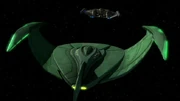
Una nave Romulana, anni del 2150
In the 2160s the tensions that existed in the 2150s between Earth and the Romulan Star Empire flared up into a full-scale interstellar war. The Earth-Romulan War was a major conflict, with military and political ramifications felt for at least two centuries. Neither side clearly prevailed. Earth and the Star Empire finally ended the violence after the Battle of Cheron and established a neutral zone as a buffer between their two spheres of influence. The neutral zone lasted into at least the 24th century. (TOS: "Balance of Terror"; TNG: "The Defector")
L'umanità e la Federazione[]
- Vedi anche: storia della Federazione
The emblem of the United Federation of Planets
The Federation, as a body, was not involved in the Earth-Romulan War. (TOS: "Balance of Terror") However, after that war Humanity's history and that of the Federation go hand in hand. The Earth Starfleet grew into the military and exploratory arm of the Federation known as simply "Starfleet" by the 23rd century. The Federation president’s office was in the city of Paris on Earth. (DS9: "Homefront", "Paradise Lost"; Star Trek VI: Rotta verso l'ignoto) Political crises and conflicts that involved the Federation drew Humanity in, and vice versa. Human involvement in Federation matters in the 23rd century were so extensive that they prompted at least one Klingon to claim in 2293 that the Federation was little more than "a 'homo sapiens' only club." (Star Trek VI: Rotta verso l'ignoto) Some major examples:
- The artificial lifeform known as V'Ger threatened to destroy all life on Earth in 2273, but was repelled by Starfleet. (Star Trek: Il film)
- The Whale Probe in 2286 was doing significant damage to Earth and Starfleet facilities; it was eliminated as a threat through the efforts of Humans and a half-Human Vulcan. (Star Trek IV: Rotta verso la Terra)
- Earth was threatened with assimilation into the Borg Collective in late 2366 and late 2373, but each instance Starfleet intervened. (TNG: "The Best of Both Worlds"; Star Trek: Primo contatto)
- In 2375, towards the end of the Dominion War, the Breen Confederacy, which had just joined the Dominion, destroyed much of Starfleet Headquarters' offices in San Francisco. The Federation Starfleet defended the planet. (DS9: "The Changing Face of Evil")
- The threat against Earth from a thalaron radiation weapon created by the Reman leader Shinzon aboard his flagship, the Scimitar in 2379 was repulsed by Starfleet. (Star Trek La nemesi)
- The Federation maintained patrol over the Romulan Neutral Zone, the result of an Earth-Romulan Star Empire treaty, into the 24th century. (TNG: "The Neutral Zone")
Despite such planetary threats, by the 24th century most Humans considered that they had turned their home planet into a paradise. (DS9: "What You Leave Behind")
Contatti con alieni pre-curvatura[]
Although official first contact came with the Vulcans landing on Earth in 2063, (Star Trek: Primo contatto) several earlier contacts with aliens (non-Humans for purposes of this article) took place under less well-known circumstances. The motivations driving these furtive contacts were sometimes less than clear, even to those they contacted. A few of these of summarized below:
- Extraterrestrial visitors, known as the "Sky Spirits", visited with and genetically altered a group of people on Earth who would later be known as the indigenous inhabitants of America. This took place about 45,000 years ago. (VOY: "Tattoo")
- As early as 4000 BC, unknown aliens took Humans to raise on planets at least 1,000 light years from Earth. Their decedents were then used as agents on Earth to promote the alien policy that Humanity should survive its own self-destructive tendencies. Who the aliens were or if those were their true motives are not clear. (TOS: "Assignment: Earth")
- The being known as Kukulkan visited the Earth and helped advance the Egyptian, Mayan, Aztec, and Chinese civilizations. Kukulkan gave those civilizations new art and agricultural techniques. (TAS: "How Sharper Than a Serpent's Tooth")
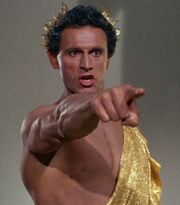
The "god" Apollo in 2267
- The ancient Greeks were visited by aliens who, for all intents and purposes, were viewed as gods by the Humans. The aliens enjoyed this treatment for awhile, until their adoration waned and they moved on. These aliens were the basis for classical Greek gods and goddesses (for example, Apollo). (TOS: "Who Mourns for Adonais?")
- Around 400 BC, a group of refugees from the Sahndara system settled on Earth and learned of the teachings of Plato. Some time afterward, they left Earth and began their own civilization as the Platonians. (TOS: "Plato's Stepchildren")
- The Q later known as Quinn visited Earth at least three times. In 1666 he assisted Isaac Newton in discovering gravity. In 1864, he saved Colonel Thaddius Riker in the American Civil War. In 1969, he assisted Maury Ginsberg in arriving at the Woodstock concert. (VOY: "Death Wish")
- In the 18th century, a group of alien anthropologists, called the Preservers, visited Earth and subsequently transplanted a group of American Indians, including people from the Delaware, Navajo, and Mohican tribes, to another planet. This was presumed to have been done to "preserve" their dying culture. Who the aliens were or if those were their true motives are not clear. (TOS: "The Paradise Syndrome")
- A group of aliens known as the Megan interacted with the population of Salem, Massachusetts. Their involvement eventually led to the Salem witch trials. Their influence may have also led to a number of other influences on Earth mythology and beliefs.
- The non-corporeal being, Onaya, was present on Earth at least twice: once during the 1st century BC where she stimulated the mind of Catullus; and again circa 1821, where she affected John Keats before departing. (DS9: "The Muse")
- The El-Aurian known as Guinan visited the Earth during the late 19th century, around 1893. She became well known in San Francisco, however her identity as a non-Human remained unknown. (TNG: "Time's Arrow")
- Alien abductions of Humans took place in at least the 19th century and 20th century. The former was done by the Skagarans, who took several thousand Humans to work as slaves on a Skagaran colony. The latter was done by the Briori, who took three hundred Humans from Earth to be used them as slaves. In both instances the Humans revolted and overcame or drove away their kidnappers. It is not know if the two cultures are related. (VOY: "The 37's"; ENT: "North Star")
- In 1957, three Vulcans crash-landed in Carbon Creek on the North American continent. They had to live among the Humans until a rescue ship finally arrived. Before leaving Earth, however, the Vulcan T'Mir traveled to a large city and sold an "invention" to a businessman: Velcro. There is also evidence that one of the Vulcans, Mestral, decided to stay behind on Earth. (ENT: "Carbon Creek")
Articoli correlati[]
- Storia interstellare
- Storia della Federazione
- Storia Andoriana
- Storia di Vulcano
Retroscena[]
This article was written – inasmuch as is reasonably possible – from the conceit that all that is known of Human history comes only from Star Trek. This is not entirely possible, as the creators of the shows presume a certain inherent familiarity by the audience with their own past. Large, and important, pieces of Earth's history have therefore been completely ignored in this article. Japan and Germany are only mentioned as aggressor nations; the historical cultures in China, Africa, Russia, Mexico and elsewhere are not mentioned at all. Others are shown in only one light. This is not a criticism of Star Trek, though; it was never intended to teach history and only mentioned historical events (real or imaginary) when it was necessary to advance a story. However, writing the article from any other, more balanced or inclusive, perspective would have 1) made the article even longer, and 2) forced upon it a level of detail that has nothing to do with Trek. People interested in the actual history of Humanity are urged to seek it elsewhere, as this is woefully – and intentionally – incomplete in that regard.
There is speculation, all of which is non-canon, as to which areas were hit by nuclear weaponry in WWIII. It is unknown, but the fact that such Western cities as San Francisco, Paris, and New Orleans, combined with the decidedly Asian appearance of the post-atomic horror trial audience and the surprising lack of references to prominent Eastern cities suggests that the Eastern Hemisphere may have been hurt the most by World War III.
According to Gene Roddenberry's novelization of Star Trek: Il film, the Mediterranean region and north Africa had remained an island of Human progress and tranquility during the savagery which had racked much of the rest of the world during the 21st century, partly due to the drastic alterations made to the old sea’s character and the region surrounding it — the fabled Mediterranean Sea was now hardly more than a long, slender lake which trailed off into the hazy blue distance in the direction from which it had just come. Human ingenuity had turned the region into a virtual garden, skillfully engineered climate alterations having profoundly improved the climate and character of the entire northern half of Africa. Population growth in the region had been compensated with underground city construction – similar habitation centers were constructed throughout the world in the later half of the century.
Regarding the origin of the Human species, in 2268 Sargon said that the story of Humans all being descended from Adam and Eve may have been based on his people having colonized Earth some six million years prior. However, Kirk replied that 23rd century science indicated life evolved independently on Earth (a conclusion later bolstered by Q). Spock thought that Sargon's people might have, instead, colonized Vulcan rather than Earth. (TOS: "Return to Tomorrow")
